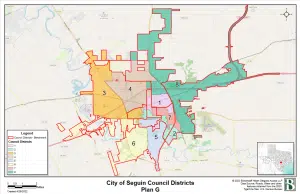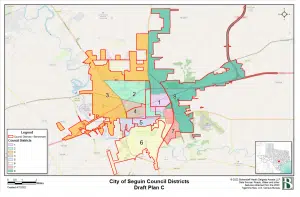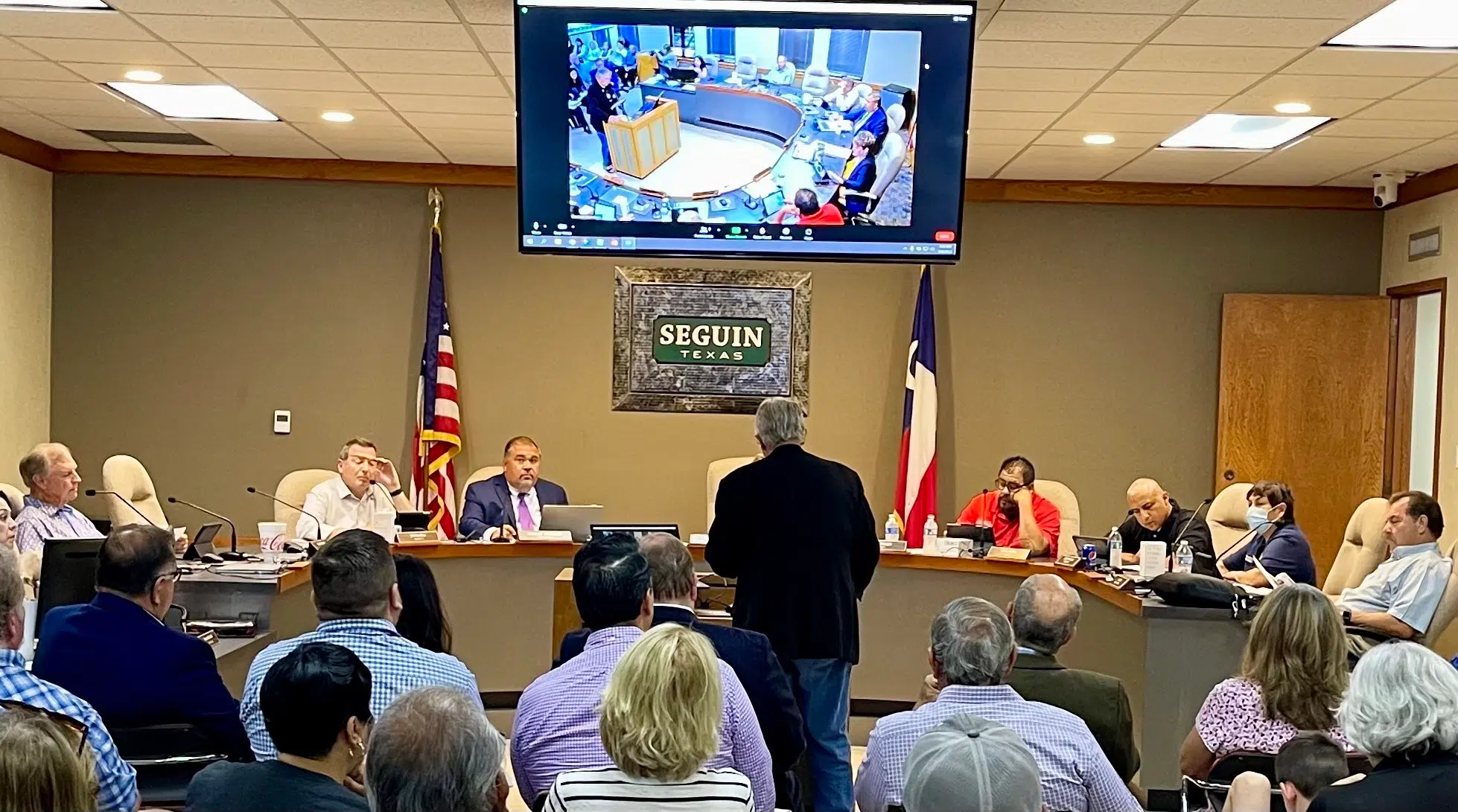(Seguin) — The Seguin City Council has taken its initial vote on the proposed redistricting plan for the city’s eight-single-member council districts. The city started its redistricting process earlier this year. The results of the 2020 Census confirmed that the populations for each council district were out of balanced, and the boundary lines needed to be redrawn.
City Attorney Andy Quittner says a six-member citizens committee was appointed to help redraw the lines and then make a recommendation to the council. Quittner explained some of the rules that the redistricting committee needed to follow in redrawing the lines.
 “If you remembered, those maps needed, a number one, keep everybody who is sitting here in their district so you could still continue to sit here by way of charter. Make the one person, one vote rule. That is make sure that the districts are nearly equal in population and that’s defined as 10 percent or less and then maintain majority, minority districts where they exist which there were four of those and so that was done on most of the maps that were presented,” said Quittner.
“If you remembered, those maps needed, a number one, keep everybody who is sitting here in their district so you could still continue to sit here by way of charter. Make the one person, one vote rule. That is make sure that the districts are nearly equal in population and that’s defined as 10 percent or less and then maintain majority, minority districts where they exist which there were four of those and so that was done on most of the maps that were presented,” said Quittner.
The committee discussed several map options during its meetings, but ultimately recommended maps identified with letters “E” and “G” to be considered by the council. A third plan was also discussed during Tuesday’s council meeting and became the favorite of some members of the redistricting committee.
Committee member Jason Biesenbach told the council he now preferred Plan C, which he said did a better job of keeping the number of Hispanic voters higher in the city’s four Hispanic majority council districts. He says “C” did the best job of also following the criteria that was expected to be followed by the redistricting committee.
“As you may have noticed, Plan C and E both follow council’s redistricting guidelines. Plan G on the other hand does not. Plan G does a poor job following natural boundaries. It also looks for this from the current districts as well as the fact that it breaks up neighborhoods. But most important is Plan G is majority, minority, districts: One, Two, Four and Five have a concerning amount of fluctuation especially when you consider number 8 of the redistricting criteria that the plan should be narrowly tailored to avoid retrogression in the position of racial minorities. The definition of retrogression being the process of returning to an earlier state typically a worst one and just as stated in the council’s memorandum in 2011, the preferred plan was changed because of a decrease of Hispanic majority below 60 percent and that is exactly what you see in District 2 and 5 of Plan G. So, with that, my recommendation and preferred plan for council would be C,” said Biesenbach.
 Committee member Jesse Trinidad disagreed, and he offered his support for Plan G, which was partially put together by the Mexican American Legal Defense Fund (MALDEF). MALDEF is the organization, along with the League of United Latin American Citizens (LULAC), that has successfully sued the city of Seguin in federal court over its redistricting processes in the past. Plan G, when presented at the last meeting of the redistricting committee, apparently had some incorrect data in it, but the committee worked with the city’s redistricting legal consultant — the Bickerstaff, Heath, Delgado, Acosta law firm in Austin — to get the numbers right that night. Trinidad says they had some trouble getting what they needed to draw this alternate map, but he says in the end — he believes Plan G is the best option for the city.
Committee member Jesse Trinidad disagreed, and he offered his support for Plan G, which was partially put together by the Mexican American Legal Defense Fund (MALDEF). MALDEF is the organization, along with the League of United Latin American Citizens (LULAC), that has successfully sued the city of Seguin in federal court over its redistricting processes in the past. Plan G, when presented at the last meeting of the redistricting committee, apparently had some incorrect data in it, but the committee worked with the city’s redistricting legal consultant — the Bickerstaff, Heath, Delgado, Acosta law firm in Austin — to get the numbers right that night. Trinidad says they had some trouble getting what they needed to draw this alternate map, but he says in the end — he believes Plan G is the best option for the city.
“We had a little bit of difficulty in getting started with drawing our maps because for one, we did not have all the data and shapefiles to begin with. Finally, we were able to get those and then we were short on time. Otherwise, I think we could have tweaked the maps a little better but I’m comfortable with Plan G. It has District 1 which is a little high in the number of Hispanics. But we maintain the majority, minority districts and then one of the key things that we were trying to do is preserve District 3 with a reasonable percentage of Hispanics and we accomplished that in Plan G. Plan E, I don’t know if that was the other one that was suggested to you all. That one distributes the Hispanics throughout the eight districts and it kind of dilutes the voting strength of Hispanics,” said Trinidad.
In its discussion with the council on Tuesday, the committee was clearly split between plans C and G. Plan E was not seriously considered during Tuesday meeting, even though it was originally recommended as one of the two plans to be forwarded on to the council for consideration. The difference largely came down to Hispanic voting numbers. Plan C did a better job of keeping the districts compact and contiguous, while also keeping the number of Hispanic voters higher in the city’s four minority-majority districts. Plan G lowered some of those numbers, but raised the number of Hispanic voters in District 3, which has largely been represented by an Hispanic council member since the city was forced to drop its at-large ward system, and then was also forced to establish eight-single member districts — all based on a federal lawsuit from the early-1990s.
Committee member Paul Castillo, who supports Plan G, says growth is going to make keeping those minority-majority districts higher, without diluting the Hispanic voting strength in some other districts. He says the city’s population is growing and expanding and that means the look of the voting map will also need to change.
“My surprise is that the Hispanic community has grown outside of where everybody used to live. Not everybody is staying where they were born or raised anymore. They’ve expanded and that is good. I love that because now, if you look at some of the census blocks, away from the city, they are pretty much equal in population. So, I think we need to look ahead and decide how these maps are going to change and change sometimes is hard to take. You change a boss, and you are not too comfortable anymore. There is all kinds of changes that we have in life. We have to get used to it. But these maps that we are presenting is a change so I would like for you to keep that in mind,” said Castillo.
Attorney Chuck Kimbrough, of the Bickerstaff, Heath, Delgado, Acosta law firm, told the council that all of the plans were balanced by population, but it was their opinion that Plan C did the best job of meeting the voting rights requirements.
“I know that the committee gave you a written recommendation of two plans to consider, the E Plan and the G Plan. We were using military acronyms, the Echo and the Golf Plans but it is my role to tell you what I believe, Sherry and our law firm believe should be the plan that you give serious attention to for approval and that is the C Plan,” said Kimbrough.
Kimbrough pointed out during Tuesday’s meeting that the C Plan was one of the plans initially put together by law firm before the committee began its work. Those plans were designed to be a starting point for the committee. But Kimbrough said that after looking at the two plans initially recommended by the committee, he agreed with those committee members who on Tuesday night said that they now supported Plan C.
“Before that first committee meeting, on April 11, they asked us to go ahead and draw a little bit, have something to begin to show the committee members and so we drew Plans A, B and C,” said Kimbrough.
Castillo expressed some concerns that Plan C was getting so much attention during Tuesday’s council meeting, when it was not formally recommended by the committee. He says that Plan G would meet all of the legal requirement for redistricting, despite the counter arguments that were made on Tuesday night.
“I guarantee you that Plan G follows within the law of all the census blocks that are allowed and as maybe next time, we are going to have to more curves, more areas that are going to extend out like tentacles but that is going to happen. My recommendation to you tonight is Plan G,” said Castillo.
The council ultimately is responsible for approving the map of their choice, and the committee was only making recommendations. The redistricting committee clearly could not reach a consensus on its recommendations to the council, which further muddied the council’s discussions on Tuesday night.
The council first entertained a motion to approve Plan C. That motion failed with council members Joe Rhea, Sonia Mendez, Chris Aviles, and Chris Rangel voting against it, while council members Jeremy Roy and Mark Herbold voted for it. A second motion was made in favor of Plan G, and it was approved on first reading. Councilman Herbold cast the lone dissenting vote for that item. Councilwoman Monica Napier-Carter was not present for the meeting and the district 7 seat remains vacant.
The city is facing a time crunch and it needed one of the plans to be approved this week. The issue will need a second and final reading before the map is adopted. A public hearing on the redistricting maps will again be held during the council’s next meeting, so the public will have a chance to again weigh-in on this issue. That council meeting will be held at 5:30 p.m. on Tuesday, May 17 at Seguin City Hall.





